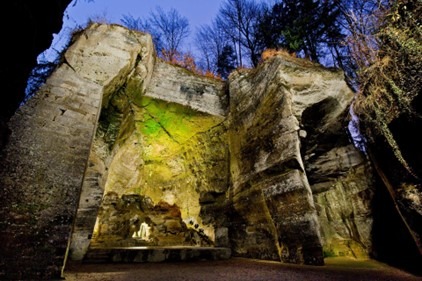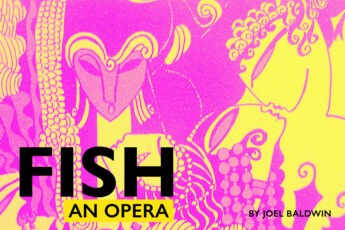FLUX was commissioned by international arts production platform, Konscht Maschinn. The interest of this Luxembourg-based organisation in ‘conceptual, video and performative art’ led to discussions between its directors and me on the possibilities of an opera without recognisable words—and more specifically, just vowel sounds being used by the singers—that could be poetically and narratively supported by additional multimedia (a film by Clemente Ciarrocca) and a detailed approach to staging (guided by costume designer Olivia Schuler-Voith). At first, I had many reservations about the effectiveness of an approach to writing an opera without a ‘real’ text. However, through these discussions and the development of a conceptual libretto that provided the necessary context and narrative ideas to steer the music, I embarked on the project with enthusiasm, excited to see how it would evolve through a process of ongoing collaboration and revision. I composed this opera scene by scene, in regular communication with filmmaker Clemente Ciarrocca to ensure our artistic voices and narrative shapes were aligned.
After a significant amount of time working and re-working the music, potential collaborators, performers and producers were brought on board to provide additional creative guidance and to realise the production, including conductor Jonathon Heyward and New York-based art house, TRIADIC. With a final draft in hand and a plan for the opera’s production in place by the autumn of 2019, it was set to be performed in the Steintheater Hellbrunn in Salzburg, Austria (see image below) in November 2020. Audiences would be invited to journey through the adjacent forest, guided by fragments of sound from the opera (both acoustic and electroacoustic elements) and additional performance art into the hidden oasis of this natural stone arena. It was to be an immersive, 360-degree experience. Body-painted performance artists, dynamic staging elements, and a spatialised sound system would augment the four singers’ and ensemble’s performance to create a hypermedial, cross-disciplinary, ‘vocalic’ opera.

Voted the audience’s favourite in the 2020 Fedora Generali Opera Prize Shortlist, we began auditioning performers and planning the production with significant funding and support in place already. Unfortunately, due to the COVID-19 pandemic, the performance was cancelled and has yet to be rearranged; and apart from fragments that have been workshopped, this 40-minute multimedia opera is yet to be performed in any meaningful capacity. Hopefully it will be staged in the near future. In the meantime, here is a short demonstration track with live-recorded instruments, voices and electroacoustic elements—a representation of the desired musical aesthetic. You can read more about the piece below (extract taken from the preface to the score submitted alongside my doctoral thesis).
FLUX: CONCEPT & INFLUENCE
FLUX was designed to experiment with ‘definitions of performance, sound and space through abstraction and linguistic primitivism.’ Konscht Maschinn had taken inspiration from works such as Oskar Kokoschka’s play, Murderer, Hope of Women (1909) and Philip Glass’s Akhnaten (1983), both of which amplify emotion and action over spoken language, deconstructing its original purpose. FLUX’s unique agenda was to realise a contemporary sense of intercultural connectedness by reimagining, disrupting, and expanding on verbal communication as a cultural barrier,’ and to explore the theatricality of a more elementary body-voice relationship.
I too was inspired by both the minimalist musical aesthetic (which expresses a certain primitivistic approach to language through repetition and fragmentation) and by types of theatre that elaborately democratise their multimedial elements, or that explored disruption or loss of dialogue in novel ways. Consider: Steve Reich’s multimedia opera, The Cave (1993), which uses repetition and fragmentation to reveal the way its religious texts have been and can be interpreted in different ways; the general theatrical approach of Japanese Noh, which ‘speaks’ as much through dance and costume as it does through music and text; Samuel Beckett’s plays, such as Not I (1972) and Quad (1981), and the semantic suturing devices required to interpret the broken or verbally empty dialogue in these plays respectively.
I also took inspiration from György Kurtág’s Fin de Partie (2018), based on the original French version of Beckett’s Endgame (1957), which presents a sense of semantic indeterminacy, without explicitly removing language or narrative. My research on Andriessen’s La Commedia and related music theatre pieces also provided a sounding board for the piece. While all these stage works still present definable words and meanings—albeit fragmented, disjointed, or semantically-nuanced—FLUX could be seen as a complete negation of language altogether. But it is, in fact, the opposite: it exists to present language in such a primitive state that the language of all the other surrounding ‘texts’—the physical, structural and aesthetic dialogues of stage, screen, light and sound—are amplified. The heightened presence of these ancillary elements imbue the semantically empty vowels with poignancy and drama, if not meaning. ‘FLUX’, as a title, refers to the way these languages interact with each other and their audio-viewers, flowing in and out of the spaces between representation and symbolism.
To find out more about the languages of FLUX, the work’s transitional links, electroacoustic elements, structure, and vocalic distribution, please see pp. 120–132 in the prefaces to my original compositions submitted in Melancholia, noise and intertextuality in Louis Andriessen’s La Commedia and portfolio of original compositions by Joel M. Baldwin.



